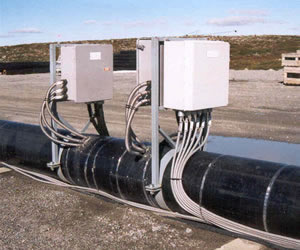Heat Tracing is a system used to maintain or raise the temperature of pipes and vessels. They can be applied to pipes, valves, flanges, and other surfaces where heat is required.
Other uses of trace heating cables include
- Ramp and stair snow / ice protection
- Gulley and roof snow / ice protection
- Underfloor heating
- Door / frame interface ice protection
- Window de-misting
- Anti-condensation
- Pond freeze protection
- Soil warming
- Anti-cavitation purpose
Purpose:
- Compensate for heat losses
- Maintain a minimum temperature (i.e. to prevent freezing)
Electric tracing for freeze protection is perhaps where this type of system is most widely used. This protection is usually where water or a process liquid may not flow for a period of time and the temperature may be below freezing for several hours or days. There are also conditions where a process material has a high viscosity or solidifies at lower temperatures and require heating in order to pump from one location to another. - Maintains the temperature of the pipe.
- Maintain a constant flow temperature in hot water systems, or to maintain process temperatures for piping that must transport substances that solidify at ambient temperatures
Heat trace is primarily used to prevent freezing by keeping a liquid above 32 degrees (or whatever temperature necessary to keep the material flowing through the piping).
Heat trace can be used to reduce viscosity of a fluid to allow for effective pumping. Heat trace may also be used to maintain a specific temperature for a material (process maintain).
Other uses of heat trace include compensation for heat loss, raising piping temperature to recover from outages, eliminate formation of liquids in gas or powder lines, and minimize the formation of solids in liquid pipes.
Difference between Insulation and Tracing :
Thermal insulation reduces the rate of heat loss but does not eliminate it. Trace heating maintains the temperature above freezing by balancing heat lost with heat supplied.
Heat or cold Tracing ?
I have always seen heat tracing
Types:
Electical
- More than 145 deg C ,
- Prefer to place on tank tops.
- They’re easier to install and maintain,
- Electrical traced systems only need to be turned on when protection is required, thereby saving energy.
Electric Trace Disadvantages:
- Limited lifetime – replacement costs
- Cant be placed in certain areas by code
Steam
- Steam-traced systems usually respond more slowly to changing heat demands.
- Steam traced systems require design considerations for evacuating the condensate. Steam trap locations and the pipeline, tracer configuration is critical on steam tracing.
- Need o have steam generation within the system
Steam Trace Disadvantages:
-
Steam leaks
-
Poor temperature control resulting in overheating
-
High operating costs, due to cost of steam
-
Trap maintenance
-
Water treatment costs
Hot Water
Alternatives to electric and steam tracing is; a heat exchanger and recycle pump external to the tank; or use of an electric element inserted directly into the tank (typically referred to as an immersion heater).
The heating element in an electric water heater is a type of immersion heater. Industrial immersion heaters are typically installed in a well that allows for maintenance and replacement without emptying the tank.
Immersion heaters are often more cost effective from both a capital and operating perspective than steam coils, heat exchangers, or electric heat trace cable.
Glycol
- More than 145 deg C
- here need to be glycol heating /cooling system in the facility
The choice of cable and controls is dependent on the type of pipe being used. Heat tracing cables may be installed continuously on water and sewer lines, or only at specific locations which are susceptible to freezing such as road crossings, fire hydrants, shallow bury locations, etc.
The electric heat tracing must maintain the pipe temperature above 0°C (32°F) when exposed to the lowest design ambient temperature while at no flow conditions.
The installed power capacity must compensate for heat loss through the pipe insulation and include a safety factor.

The principal considerations in selecting the correct heat tracer is:
- the energy (wattage) required of the system to be traced.
- the electrical classification in areas where special environmental conditions exist.
- the temperature limits for the tracer. This is usually determined by the cable jacket material.
- the cost considerations.
- length of pipe, including valves and flanges, to be traced and length of tracer on equipment.